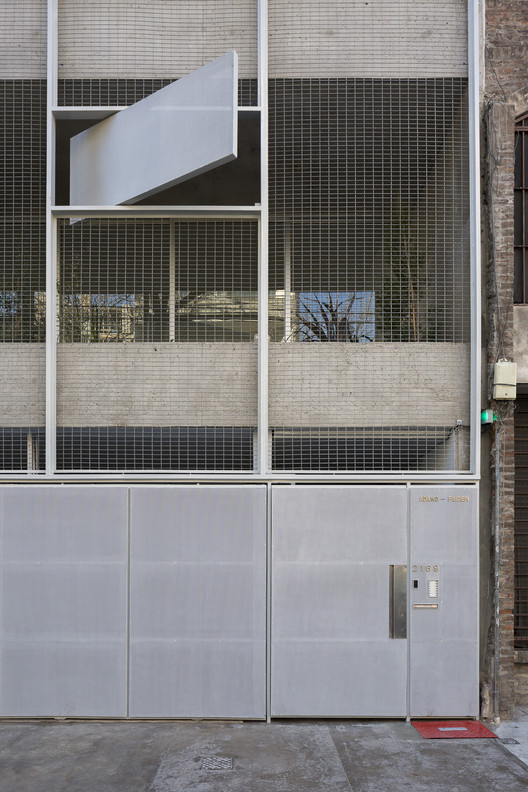Makoko Floating School NLE Architects
2013-03-14 01:00
架构师提供的文本描述。休息后加入我们的项目更多的照片。
Text description provided by the architects. Join us after the break for more photos of the project.
Makoko Floating School © NLÉ architects
在世界上最脆弱的沿海社区,不可预测的气候变化产生了一些引人入胜的设计解决方案,测试了建筑可能性的弹性和适应的需要,从而产生了这些变化。尼日利亚拉各斯泻湖附近的贫民窟Makoko沿海社区正在升级其目前的解决方案,即在泻湖水域建造高跷支撑房屋。NLE建筑师在联合国开发计划署(开发署)和德国海因里希·博尔基金会的赞助下,设计了马科科浮动学校,这是一个三期开发项目的第一阶段,它将成为一个由联锁和浮动住宅组成的浮动社区。该项目的建设于2012年10月开始,上个月刚刚完成,社区和联合国游客对此进行了隆重的评估。
Unpredictable climate changes along the world's most vulnerable coastal communities, have produced some fascinating design solutions that test the resiliency of architectural possibilities and the need for adaptation that will produce these changes. The coastal community of Makoko, a slum neighborhood, off the Lagos Lagoon in Lagos, Nigeria is receiving an upgrade to its current solution, which is building homes supported on stilts within the lagoon's waters. NLE Architects, with sponsoring from United Nations Development Programme (UNDP) and Heinrich Boell Foundation from Germany, designed the Makoko Floating School, phase one of a three-phase development that will become a floating community of interlocked and floating residences. Construction on the project began in October 2012 and was completed just last month with grand appraisal from the community and UN visitors.
Makoko Floating School © NLÉ architects
Makoko浮动学校和计划中的全部项目利用当地的材料和资源来制作符合人民需要和反映社区文化的建筑。以木材为主要材料,作为完成学校的结构、支撑和修整。整个设计的组成是一个三角形的A-框架截面.教室位于第二层。它们部分用可调节的百叶窗板围起来。教室周围是公共绿地,下面有一个操场,屋顶上还有一个额外的露天教室。NLE还采用了一些策略,通过在屋顶上安装光伏电池,并结合雨水收集系统,使浮动建筑得以持续。该结构也是自然通风和通风。
The Makoko Floating School and the total planned projects makes use of local materials and resources to produce architecture that applies to the needs of people and reflects the culture of the community. Wood is used as the main material as the structure, support and finishing for the completed school. The overall composition of the design is a triangular A-Frame section. The classrooms are located on the second tier. They are partially enclosed with adjustable louvered slats. The classrooms are surrounded by public green space, there is a playground below, and the roof contains an additional open air classroom. NLE has also employed strategies to make the floating architecture sustainable by applying PV cells to the roof and incorporating a rainwater catchment system. The structure is also naturally ventilated and aerated.
Makoko Floating School © NLÉ architects
但是它是如何浮起的呢?完整的结构是建立在一个典型的塑料桶的基础上的。这个简单的解决方案反映了可提供多种用途的可用材料的重用。外围的桶可以用来储存来自集水区系统的多余雨水。
But how does it float? The completed structure rests on a base of typical plastic barrels. This simple solution reflects a reuse of available materials that can provide multiple uses. The barrels at the periphery can be used to store excess rainwater from the catchment system.
Makoko Floating School © NLÉ architects
该项目的第二阶段将包括建造与学校一样美观的个人住宅。这些元素将能够相互连接或独立浮动。第三阶段将允许开发一个大型的浮动体系结构社区。Makoko的鸟瞰显示,随着房屋越来越深入到泻湖,房屋变得多么不密集。这种架构,就像它现在存在的那样,在高跷上得到了支持。NLE的愿景将带来一层新的家庭,漂浮在地图上所示的Makoko浮动学校之上。
The second phase of the project will include the construction of individual homes that follow the same aesthetic as the school. These elements will be able to connect to each other or may float independently. Phase three will allow for the development a large community of floating architecture. An aerial view of Makoko shows how less dense the homes become as the homes get further and further into the lagoon. The architecture, as it exists today, is supported on stilts. NLE's vision will bring a new layer of homes, floating just beyond where the Makoko Floating School is indicated on the map.
Makoko, Lagos, Nigeria; Image Capture © Google Maps 2013
Makoko,拉各斯,尼日利亚;图像捕获(Google Maps,2013年)
拉各斯政府在很大程度上是一个自给自足、自治的渔业社区,今年夏天,拉各斯政府摧毁并驱逐了居民,没收了沿着滨水区进行重建的房产。从政治或环境标准来看,Makoko的未来尚不明朗。但是NLE设计和发展一个可持续的浮动社区及其联合国的支持表明,该社区期待着适应其架构的弹性。
Largely a self-sustaining, self-governing fishing community, this past summer the Lagos government destroyed and evicted residents to seize property for redevelopment along the waterfront. What the future of Makoko will be is unclear - by political or environmental standards. But NLE's design and development of a sustainable floating community and its UN support indicates that the community is looking forward to adapting a resilience to its architecture.
Makoko Floating School © NLÉ architects
马科科浮动学校并不是唯一一个发展浮动概念以应对不可预测的气候变化和全球海平面变化的项目。去年,我们介绍了孟加拉国的流动学校,由建筑师穆罕默德·雷兹万(Mohammed Rezwan)经营的非营利性的Shidhulai Swanirvar Sangstha资助。与此同时,荷兰的Practice Waterstudio开发了许多创新的解决方案,用于建造和设计离岸住宅以及开发应急住房。
The Makoko Floating School is not the only project to develop a floating concept to combat unpredictable climate changes and global sea level changes. Last year, we presented the floating schools of Bangladesh supported by the non-profit Shidhulai Swanirvar Sangstha run by architect Mohammed Rezwan. Meanwhile, Dutch-based practice Waterstudio has developed numerous innovative solutions to building and designing offshore homes and developing emergency housing.
Images Courtesy of Design Boom
 举报
举报
别默默的看了,快登录帮我评论一下吧!:)
注册
登录
更多评论
相关文章
-

描边风设计中,最容易犯的8种问题分析
2018年走过了四分之一,LOGO设计趋势也清晰了LOGO设计
-

描边风设计中,最容易犯的8种问题分析
2018年走过了四分之一,LOGO设计趋势也清晰了LOGO设计
-

描边风设计中,最容易犯的8种问题分析
2018年走过了四分之一,LOGO设计趋势也清晰了LOGO设计




































